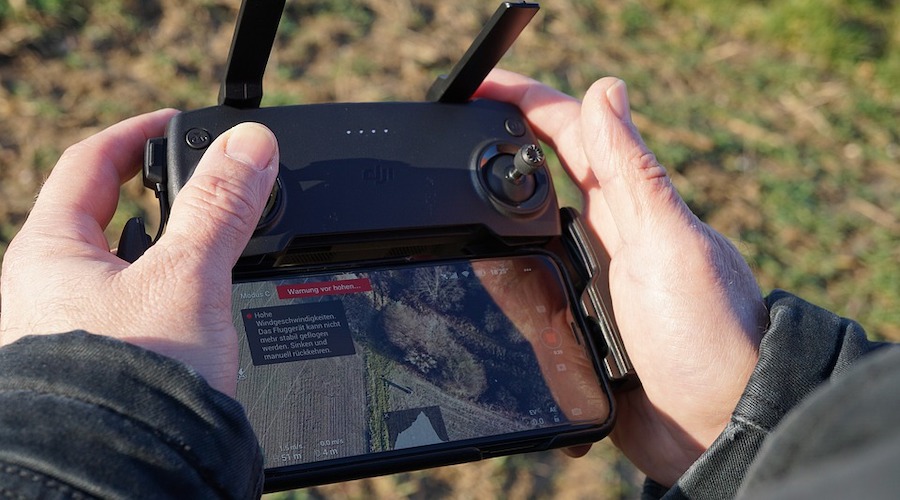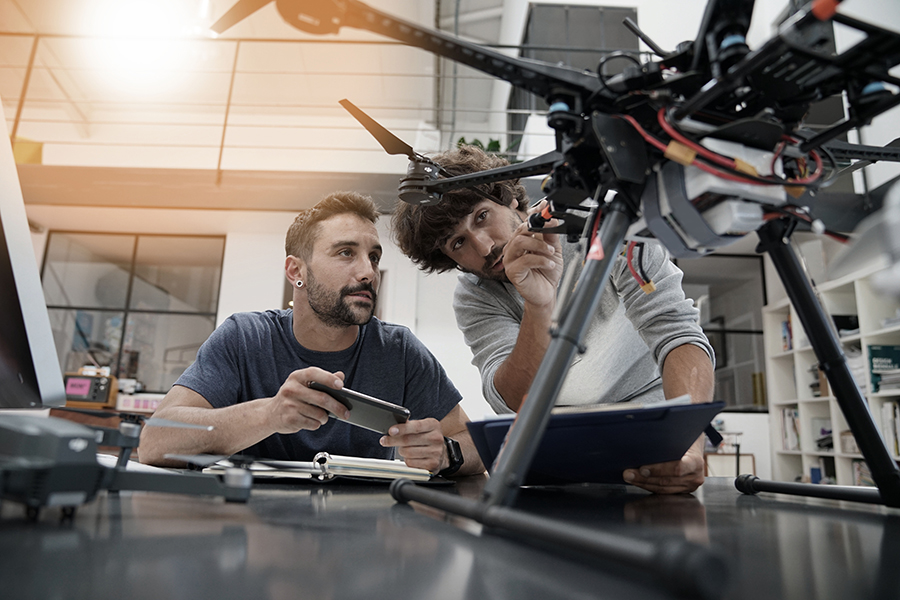Drones are fast becoming important tools in several modern industries. We’ve written a great deal about how drones are used to inspect power lines, plan mining projects, manage crop health, or help sell real estate. These are less common than aerial photography and truly highlight how versatile drone technology is.
However, there are also uses of drones that are far more unusual. While none of these strange uses have hit the mainstream yet, it won’t be surprising if we see more and more of them in the near future. Check out our list of the strangest and most unusual ways that people and companies are using drones nowadays.
Window cleaning
Let’s start with something simple, yet unsurprising: the use of drones for window cleaning. The old-fashioned way of window cleaning was both slow and risky. Not only would it take weeks for teams of window cleaners to finishing a single building, but they are also constantly exposed to the hazards of working at heights.
Several companies have stepped up by introducing drones to the job. Aerones Drones has been at the forefront of this field of application using their extremely powerful Aerones AD28 Heavy Lift drone. With more than 10 rotors, this drone can carry a payload up to 200 kilograms and discharge water through a spray nozzle at pressures of up to 500 bar. It is also equipped with a large sponge at the front of its frame, allowing the operator to scrub off any residue that cannot be removed by the pressurized water jets.
The AD28 is powered by a tethered connection and can also be augmented with a hose for constant water supply. At its current design, it can gain an altitude of up to 350 meters and still remain connected to the water tank and battery at the ground.
Window Cleaning Drones is another company that offers the same service. They currently offer two types of drones for window cleaning: an industrial-sized eight-rotor drone for buildings and a much smaller “home” version. Their drones have also been used to clean solar panels that are typically located on rooftops or otherwise hard to reach areas.
Mobile cellular base station
Despite the fact that everyone has a smartphone nowadays, there is still the reality that not every single place in the world has cellular signal coverage. When a natural disaster strikes, it typically also cripples the telecommunication facilities in an area, making it more difficult for first responder teams to operate.
With this need in mind, researchers from the University of North Texas have explored the use of drones to provide an airborne communication system. The so-called “Aerial Deployable Communication System” had been tested in Waxahachie, Texas back in 2017. The transmission device was mounted on a drone, which was then allowed to hover at an altitude of 400 feet. Using just 250 milliwatts of transmission power, the system was able to provide cellular coverage to an area measuring about two kilometers across.
According to the researchers, the system can be scaled up to a transmission power of 10 watts, which should allow it to provide cellular coverage to a city with a population of about 100,000 people.
The system still needs development, particularly in extending the time that a drone can stay airborne and in the reliability of cellular service it can provide. However, this is a good first step in providing communications support to emergency response and search and rescue teams.
Aerial light shows
In the recent years, drones seem to be taking the role of fireworks as the go-to technology for producing aerial light shows. Unlike fireworks, drones can be programmed to execute more intricate patterns and can be reused several times. This is a service that is now being offered by several companies like SkyMagic and Dronisos.
An aerial light show isn’t something that any professional drone pilot can execute, mostly because you are going to need a literal fleet of drones to pull it off. There also needs to be some sophisticated AI behind the drones, dictating where they will fly and when their lights will be activated. In many ways, a drone light show is one of the best intersections of art, science, and technology.
The first demonstration of this technology happened way back in 2012 in Austria by a company called Ars Electronica FutureLab. In the past years, more high-profile examples have made the public familiar with drone light technology. Among the most popular examples are the light shows in the 2018 Winter Olympics in South Korea, the halftime shows of the 2017 and 2019 Superbowl, the 4th of July celebration in 2018, and the ending ceremony of the South Asian Games 2019 in Nepal.
Amazon Prime Air delivery
Amazon Prime Air is a service that Amazon is trying to introduce that will allow them to deliver packages weighing up to five pounds using drones. The concept was introduced by Jeff Bezos way back in 2013 but has yet to materialize. Aside from the technological challenges of such an undertaking, the project has also run regulatory restrictions.
Delivery drones are limited to delivering parcels within a 10-mile radius. To fulfill deliveries over large distances, Amazon is planning to establish a beehive network of smaller warehouses to which parcels can be passed around until they reach their final destinations.
All Amazon Prime Air drones will have an active Internet connection, making it possible to control the entire fleet autonomously. Among the features that have been proposed for these drones are object detection and identification, GPS-guided flight paths, obstacle avoidance sensors, enhanced image resolution, and gigapixel cameras.
Amazon posted a video of their first successful demonstration of Amazon Prime Air, which happened in December 2016 in Cambridge, England. It was a fully autonomous drone trip that only took 13 minutes to deliver a parcel containing an Amazon Fire Stick and a bag of chips.
There’s no word yet on when this concept will become reality as there are still a lot of concerns about the safety and privacy of having a fleet of drones fly around neighborhoods.
Serving sushi
London-based restaurant chain YO! Sushi takes the cakes for having one of the most unusual uses of drones. Instead of waiters, the chain serves their food through what they call the “iTray” – a four-rotor drone with a flat top where a plate with food can be placed. The drone is controlled by a waiter, who is just standing nearby, using an iPad. There are also two cameras on the drone that help the waiter guide it to the desired location.
Since the drone still requires manual operation by a pilot, it doesn’t really help free up any of the restaurant’s workforce. As a novelty, however, it’s very effective. The marketing move has given the restaurant chain a lot of media exposure, especially for the new Sushi Burger that they were aiming to promote. The goal was to promote the new menu item in a light and exciting way – and the iTray was the perfect solution.
There hasn’t been any news on whether the iTray was initiative was sustained for the long term, but there several other restaurants that have adopted similar uses of drones. One of the more popular examples is the DomiCopter, a service by Domino’s Pizza that uses a drone to airdrop pizzas for delivery.
Ambulance drones
Emergency health response is a situation where every second counts. The treatment of a patient in the first few minutes plays a huge role in determining how likely they are to survive and how well they recover.
The problem is that most bystanders do not know how to respond to a health emergency, wasting precious minutes before a qualified first responder can attend to the situation. This the gap that the Ambulance Drone, developed by researchers in the Delft University in Netherlands, seeks to address.
The Ambulance Drone can arrive at the scene of the emergency in less time than it would take an emergency response team. Through two-way video communication, a medical team can coach people on the scene to conduct first aid, in the hopes of preventing any long-term disability to the patient and improve the chances of survival. The Ambulance Drone also comes with a mobile Automated Defibrillator (AED) which the first responders can use in a cardiac arrest has happened.
As of writing, the project is seeking financial support for it to be tested at a larger scale. As is typical with novel research projects like this, funding is still a challenge before it can be used for commercial exploitation.
Aerial construction
Drones are already being used to help plan and monitor construction projects but researchers in the Swiss Federal Institute of Technology believe that they can be used for so much more. The Aerial Construction Project aims to develop the use of drones for robotic aerial construction, giving them tasks like laying building foundations.
The proponents of the study argue that drones have the benefit of being able to easily access areas that would be otherwise impossible for large construction equipment or dangerous for human crews. However, they are also limited in the weight of payload they can carry and how accurately they can place any structures.
The first and only demonstration of this concept was done by a drone that was used to construct a room-scale rope bridge. Using a drone and established anchor points, a drone connected to a rope flew around the structures creating the tensile elements that formed the bridge’s foundations. Overall, around 120 meters of rope were spun through the 7.4-meter gap separating the anchor points.
There is still a long way to go before such a system can be upscaled to the level of creating real bridges and buildings. Still, this could be the first step of a long journey which may eventually revolutionize the construction industry, allowing for construction work to be done in a safer and more efficient manner.
Final thoughts
Despite all the commercial and industrial applications of drones, let’s not forget that this technology is still very young and still has a lot of potential. In the coming years, we’re probably going to see drones either in surprising places or as part of our everyday lives. Signs of this are already present right now with the strong push for automated drone-based parcel delivery by Amazon.
It’s worth noting that the widespread adoption and commercial upscaling of many of the strange applications of drones listed here are limited either by federal regulations or by the limitations of drone technology. Considering how dynamic the industry has been in the past few years, it won’t be surprising if drones overcome both these barriers and become even more commercially relevant than they are now.


